加涅的教学理论
加涅的教学设计理论最新版

加涅的教学设计理论最新版加涅的教学设计理论最新版下面是店铺收集整理的关于加涅的教学设计理论,欢迎参考!《教学设计原理》是加涅关于学习的结果分类与教学事件比较系统的著作,较为系统地介绍了教学设计的基本原理与方法。
全书共分三个部分:第一部分是教学系统绪论,第二部分是学习与教学的基本过程;第三部分是设计教学。
第一部分:教学系统绪论的主要内容有:1、关于学习的假设;2、关于学习的基本原理。
关于学习:学习是伴随一定经验之后,人的行为和产生特殊行为的性能发生变化。
3、关于学习的条件。
关于教学:教学必须考虑影响学习的全部因素,整体而言,可以把它们称作学习的条件(分为外部条件和内部条件)。
用学习的信息加工模型来说明学习的过程,并针对整个过程的影响,提出了九大教学事件,这块内容在被何克抗先生称为九五矩阵。
4、教学设计的理论基础:系统论的思想第二部分:学习与教学的基本过程:此章介绍的是教学系统和ID的系统观。
教学系统有多种形式和层次水平:第一层次称为“教学设计”,适于单元和单课的教学设计,个人感觉,Dick & Carey在其《教学系统设计》中重点阐述的教学设计模式即属于此类层次的教学设计;第二层次即教育系统设计,是超出课堂与教学单元的系统水平的教育系统设计,学校的校本课程设计、某学科的课程设计应该属于此类。
第三部分:设计教学。
1、教学和教育目的;2、学习结果的五种类别:(一) 智慧技能:如何完成某种智慧行为,从造句这样的基本语言技能到学科工程工其它学科的高级技术性能。
Anderson(1985)认为这是一种程序性知识。
由低到高分别是:辨别——>具体概念——>规则和定义性概念——>高级规则——>问题解决。
(二) 认知策略:支配个体自身的学习、记忆和思维行为的性能。
由Weinstein和R?E?Mayer1986年提出的分为复述策略、精加工策略、理解监控策略、情感策略。
(三) 言语信息:又称为陈述性知识,以合乎语言规则的命题形式存储的。
加涅定义概念

加涅(R. M. Gagne)是一位著名的教育心理学家,他的研究成果对教育界和心理界产生了深远影响。
他提出了许多有关学习、教学和课程开发的概念和理论。
以下是一些与加涅相关的定义概念:
1. 信息加工理论:加涅提出了信息加工理论,认为学习是一个信息加工过程,包括感知、注意、记忆、理解、应用等阶段。
2. 累积学习理论:加涅认为学习是一种累积过程,新的学习依赖于先前学习的基础。
他提出了九种学习类别,按照从简单到复杂的顺序排列,分别是:信号学习、刺激反应学习、连锁学习、言语联想学习、辨别学习、概念学习、规则或原理学习、高级规则学习、解决问题学习。
3. 学习风格:加涅根据学习者的认知风格和信息加工方式将学习风格分为四种:场独立型、场依存型、基质型和同化型。
4. 教学设计:加涅提倡以学习为导向的教学设计,强调教学目标、教学方法、教学评价等方面的系统性和科学性。
他提出了五段教学模式,包括:导入、演示、解释、操作和总结。
5. 动机分类:加涅将动机分为内在动机和外在动机,并提出了八种激发学习动机的策略,分别是:归属感、合作、认可、竞争、好奇心、序列、成长和成就。
6. 课程评价:加涅提倡对课程进行持续、系统的评价,以了解学习者的需求、教学效果和改进方向。
加涅学习理论对教学的启示

加涅学习理论对教学的启示
加涅学习理论是20世纪70年代末由英国心理学家John B.Carney 提出来的一种教学理论。
它提出了学习是一个动态的过程,学习者必须接受新的信息,结合现有的知识,进行思考,才能达到真正的学习目的。
加涅学习理论对教学有着重要的启示。
首先,教学不应只是传授知识,而应该把引导学生思考作为重点。
教师应该利用问题、案例等方式,引导学生思考,帮助学生建立新的知识结构,解决新的问题。
其次,教学应该注重学习者的主体性。
教师应该充分考虑到学习者的年龄、背景和特点,依据学生的实际情况,采取有针对性的教学方法,增强学习者的主观性,激发学习者的学习兴趣。
最后,教师应通过反馈的方式,指导学生进行自我评价。
在学习过程中,教师应给予学生及时的反馈,指出学生的优点和不足,有效地帮助学生改进,从而完成真正的学习。
总之,加涅学习理论给教学带来了重要的启示,教师应该采用有针对性的教学方法,利用问题和案例引导学生思考,重视学生的主体性,并通过反馈指导学生自我评价,从而更好地提高学习效果。
加涅教学设计理论体系分析

加涅教学设计理论体系分析加涅教学设计理论体系是由加涅(Jean Piaget)提出的一种教学设计理论体系。
他是瑞士的心理学家和教育家,对儿童认知发展和教育有深入的研究。
加涅教学设计理论体系主要关注儿童认知发展的阶段和过程,并将这些认知阶段的特点应用到教学设计中。
1.认知发展阶段的理论:加涅提出了四个认知发展的阶段,包括感知动作阶段、前运算阶段、具体运算阶段和形式运算阶段。
这四个阶段描述了儿童在认知发展过程中的不同特点和能力。
教学设计需要根据儿童所处的认知阶段来确定教学目标和教学方法。
2.教学目标的设定:教学目标应该与儿童的认知发展阶段相适应。
在感知动作阶段,儿童主要通过感觉和动作来认识世界,教学目标应该注重培养他们的观察和操作能力;在前运算阶段,儿童开始具备一定的符号理解和思维能力,教学目标应该注重培养他们的逻辑思维和问题解决能力;在具体运算和形式运算阶段,儿童逐渐具备抽象思维能力,教学目标应该注重培养他们的分析和推理能力。
3.教学方法的选择:教学方法应该根据儿童的认知发展阶段和特点来选择。
在感知动作阶段,教学方法可以采用实践操作、游戏和故事等方式,帮助儿童通过感官和动作来认识世界;在前运算阶段,教学方法可以采用问题解决、探究和合作学习等方式,培养儿童的思维能力和合作精神;在具体运算和形式运算阶段,教学方法可以采用系统讲解、练习和评价等方式,帮助儿童掌握抽象概念和运算方法。
4.评价方法的选择:教学评价应该与教学目标和儿童的认知发展阶段相适应。
在感知动作阶段,评价可以采用观察和记录的方式,了解儿童的观察和操作能力;在前运算阶段,评价可以采用问题解决和情境分析的方式,了解儿童的思维能力和问题解决能力;在具体运算和形式运算阶段,评价可以采用练习和测试的方式,了解儿童对抽象概念和运算方法的掌握情况。
综上所述,加涅教学设计理论体系将儿童的认知发展阶段与教学设计相结合,帮助教师更好地理解儿童的认知特点和需求,并根据这些特点和需求进行相应的教学设计和评价。
加涅的教学设计理论的评价
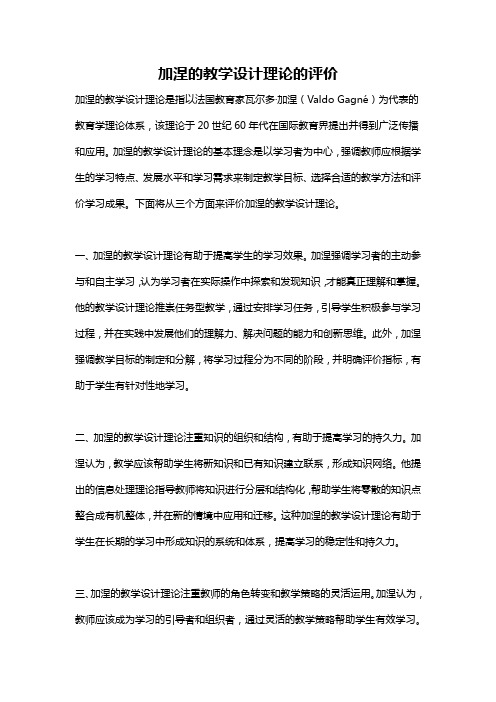
加涅的教学设计理论的评价加涅的教学设计理论是指以法国教育家瓦尔多·加涅(Valdo Gagné)为代表的教育学理论体系,该理论于20世纪60年代在国际教育界提出并得到广泛传播和应用。
加涅的教学设计理论的基本理念是以学习者为中心,强调教师应根据学生的学习特点、发展水平和学习需求来制定教学目标、选择合适的教学方法和评价学习成果。
下面将从三个方面来评价加涅的教学设计理论。
一、加涅的教学设计理论有助于提高学生的学习效果。
加涅强调学习者的主动参与和自主学习,认为学习者在实际操作中探索和发现知识,才能真正理解和掌握。
他的教学设计理论推崇任务型教学,通过安排学习任务,引导学生积极参与学习过程,并在实践中发展他们的理解力、解决问题的能力和创新思维。
此外,加涅强调教学目标的制定和分解,将学习过程分为不同的阶段,并明确评价指标,有助于学生有针对性地学习。
二、加涅的教学设计理论注重知识的组织和结构,有助于提高学习的持久力。
加涅认为,教学应该帮助学生将新知识和已有知识建立联系,形成知识网络。
他提出的信息处理理论指导教师将知识进行分层和结构化,帮助学生将零散的知识点整合成有机整体,并在新的情境中应用和迁移。
这种加涅的教学设计理论有助于学生在长期的学习中形成知识的系统和体系,提高学习的稳定性和持久力。
三、加涅的教学设计理论注重教师的角色转变和教学策略的灵活运用。
加涅认为,教师应该成为学习的引导者和组织者,通过灵活的教学策略帮助学生有效学习。
他提出的直接教学和间接教学策略都强调学生参与和实践,但具体的运用根据学习目标、学生需求和教学情境来决定。
这种教学设计理论的优势在于充分考虑了学生的个体差异和学习特点,以及教学环境的变化,使教学更加灵活多样。
综上所述,加涅的教学设计理论通过以学习者为中心、注重知识组织和结构,以及教师角色的转变和教学策略的灵活运用等方面的理念和方法,有助于提高学生的学习效果、持久力和教学质量。
加涅教学设计原理

加涅教学设计原理教学设计是教学活动的核心,是教师对学生学习活动进行规划和组织的过程。
在教学设计中,加涅教学设计原理是一种重要的教学设计理论,它包括了一系列的原则和方法,可以帮助教师更好地进行教学设计,提高教学效果。
下面我们将详细介绍加涅教学设计原理的相关内容。
首先,加涅教学设计原理强调以学生为中心。
在教学设计中,要充分考虑学生的学习需求、兴趣爱好和学习特点,根据学生的实际情况进行灵活的教学设计,使教学内容更贴近学生的生活和学习实际,激发学生的学习兴趣,提高学习积极性。
其次,加涅教学设计原理注重启发式教学。
启发式教学是一种以问题为中心的教学方法,通过提出问题和情境,引导学生主动探究和发现知识,培养学生的创造性思维和解决问题的能力。
在教学设计中,教师可以设计一些启发性的问题和情境,引导学生主动思考和探索,从而提高学生的学习效果。
另外,加涅教学设计原理提倡因材施教。
因材施教是根据学生的不同学习能力和兴趣特点,采取不同的教学方法和手段,使每个学生都能得到适合自己的教学内容和方式。
在教学设计中,教师需要根据学生的实际情况,灵活运用不同的教学策略,满足学生的个性化学习需求。
此外,加涅教学设计原理强调实践导向。
实践导向是指教学设计要贴近实际生活和社会实践,注重培养学生的实践能力和创新精神。
在教学设计中,教师可以通过设计一些实践性的教学活动,引导学生进行实际操作和实践探究,使学生能够将所学知识运用到实际生活中,提高学生的实际应用能力。
最后,加涅教学设计原理倡导多元评价。
多元评价是指教学设计要注重对学生的多方面能力进行评价,包括知识、能力、情感、态度等方面,通过多种评价方式和工具,全面了解学生的学习情况,为教学设计和教学改进提供有效的依据。
综上所述,加涅教学设计原理是一种以学生为中心、注重启发式教学、因材施教、实践导向和多元评价的教学设计理论,它可以帮助教师更好地进行教学设计,提高教学效果,激发学生的学习兴趣,培养学生的创造性思维和实际应用能力。
加涅学习理论对教学的启示研究
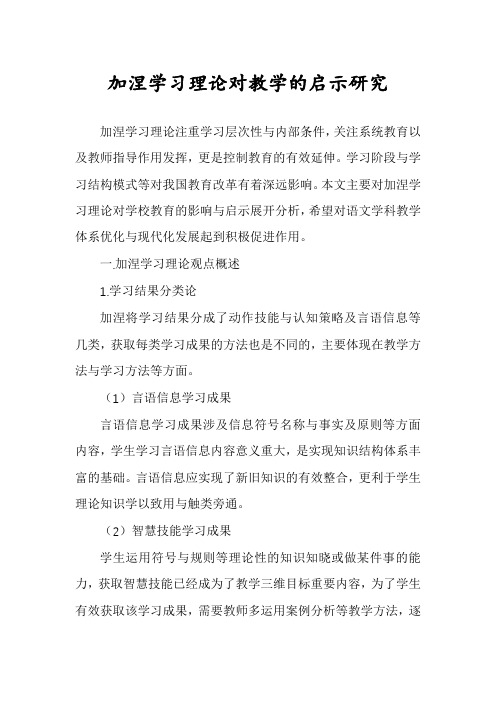
加涅学习理论对教学的启示研究加涅学习理论注重学习层次性与内部条件,关注系统教育以及教师指导作用发挥,更是控制教育的有效延伸。
学习阶段与学习结构模式等对我国教育改革有着深远影响。
本文主要对加涅学习理论对学校教育的影响与启示展开分析,希望对语文学科教学体系优化与现代化发展起到积极促进作用。
一.加涅学习理论观点概述1.学习结果分类论加涅将学习结果分成了动作技能与认知策略及言语信息等几类,获取每类学习成果的方法也是不同的,主要体现在教学方法与学习方法等方面。
(1)言语信息学习成果言语信息学习成果涉及信息符号名称与事实及原则等方面内容,学生学习言语信息内容意义重大,是实现知识结构体系丰富的基础。
言语信息应实现了新旧知识的有效整合,更利于学生理论知识学以致用与触类旁通。
(2)智慧技能学习成果学生运用符号与规则等理论性的知识知晓或做某件事的能力,获取智慧技能已经成为了教学三维目标重要内容,为了学生有效获取该学习成果,需要教师多运用案例分析等教学方法,逐步强化学生问题分析与解决能力,从而掌握更多问题解决方法。
通过观察学生举例或问题解决情况,了解学生该学习成果的掌握情况。
(3)认知策略学习成果认知策略学习成果属于智慧技能范畴,是学生利用规则或概念实现自我调控的能力,能够帮助学生更高效的解决问题。
学生对策略的实践与学习,需要教师的示范描述与引导,并通过组织学生解决新问题,了解学生认知能力掌握程度。
(4)动作技能学习技能动作技能学习技能是学生利用规则控制肌肉协调性的能力,操练是逐步强化学生对动作技能掌握与运用能力的关键,要求学生在指定时间内与高精准度等条件下完成某项任务,是考察学生该学习结果掌握情况的直接途径。
(5)态度学习成果态度学习成果对学生言行举止有着直接影响,通过提供榜样范例等方法,更利于学生获得态度这一学习成果。
2.学习层级论加涅在分析了认知心理学与综合行为主义理论的基础上提出了学习分类观,其认为学习类型多样化,按照低高层次顺序排列,涉及信号学习与刺激及反应学习等类型。
(完整word版)加涅的学习理论
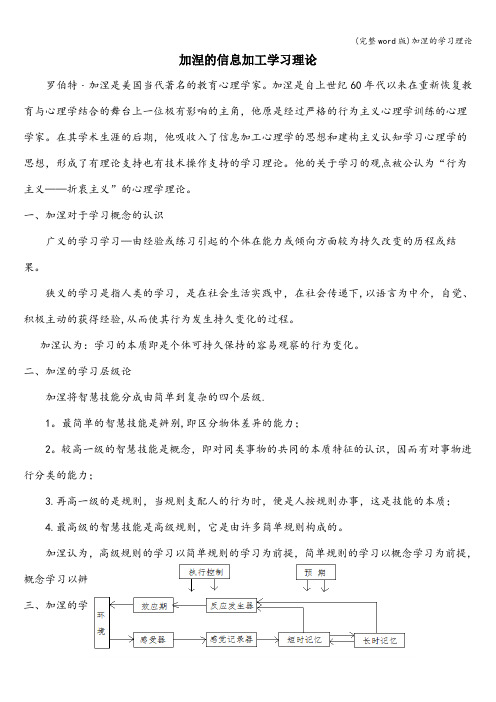
加涅的信息加工学习理论罗伯特・加涅是美国当代著名的教育心理学家。
加涅是自上世纪60年代以来在重新恢复教育与心理学结合的舞台上一位极有影响的主角,他原是经过严格的行为主义心理学训练的心理学家。
在其学术生涯的后期,他吸收入了信息加工心理学的思想和建构主义认知学习心理学的思想,形成了有理论支持也有技术操作支持的学习理论。
他的关于学习的观点被公认为“行为主义——折衷主义”的心理学理论。
一、加涅对于学习概念的认识广义的学习学习—由经验或练习引起的个体在能力或倾向方面较为持久改变的历程或结果。
狭义的学习是指人类的学习,是在社会生活实践中,在社会传递下,以语言为中介,自觉、积极主动的获得经验,从而使其行为发生持久变化的过程。
加涅认为:学习的本质即是个体可持久保持的容易观察的行为变化。
二、加涅的学习层级论加涅将智慧技能分成由简单到复杂的四个层级.1。
最简单的智慧技能是辨别,即区分物体差异的能力;2。
较高一级的智慧技能是概念,即对同类事物的共同的本质特征的认识,因而有对事物进行分类的能力;3.再高一级的是规则,当规则支配人的行为时,便是人按规则办事,这是技能的本质;4.最高级的智慧技能是高级规则,它是由许多简单规则构成的。
加涅认为,高级规则的学习以简单规则的学习为前提,简单规则的学习以概念学习为前提,概念学习以辨别学习为前提。
三、加涅的学习过程论加涅——学习的信息加工模式在这个模式中,执行控制和期望是两个重要的结构,它们可以激发或改变信息流的加工.执行控制是已有的经验对当前学习过程的影响,起调节作用;预期是动机系统对学习的影响,起定向作用,它们可以对整个信息加工过程起调节和监督的功能。
四、加涅的学习条件论加涅认为,学习的条件有内部的和外部的。
内部的学习条件包括学习者固有的内部状态(包括先天的和先天与后天相互作用发展形成的,如工作记忆容量、IQ和人格特质),和已习得的性能(言语信息、智慧技能、认知策略、动作技能和态度)。
加涅的教学设计原理
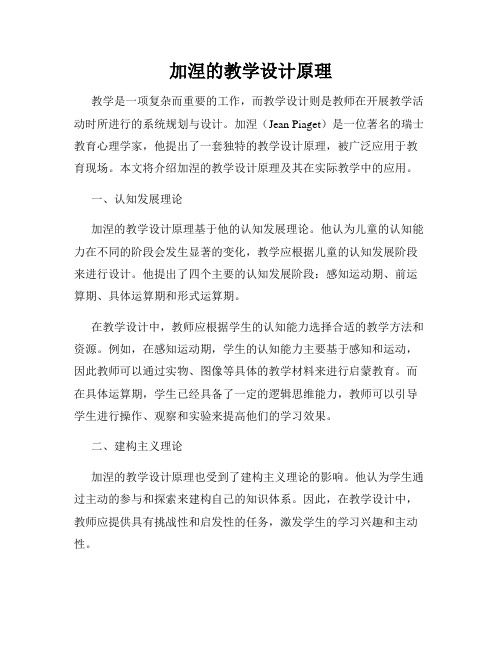
加涅的教学设计原理教学是一项复杂而重要的工作,而教学设计则是教师在开展教学活动时所进行的系统规划与设计。
加涅(Jean Piaget)是一位著名的瑞士教育心理学家,他提出了一套独特的教学设计原理,被广泛应用于教育现场。
本文将介绍加涅的教学设计原理及其在实际教学中的应用。
一、认知发展理论加涅的教学设计原理基于他的认知发展理论。
他认为儿童的认知能力在不同的阶段会发生显著的变化,教学应根据儿童的认知发展阶段来进行设计。
他提出了四个主要的认知发展阶段:感知运动期、前运算期、具体运算期和形式运算期。
在教学设计中,教师应根据学生的认知能力选择合适的教学方法和资源。
例如,在感知运动期,学生的认知能力主要基于感知和运动,因此教师可以通过实物、图像等具体的教学材料来进行启蒙教育。
而在具体运算期,学生已经具备了一定的逻辑思维能力,教师可以引导学生进行操作、观察和实验来提高他们的学习效果。
二、建构主义理论加涅的教学设计原理也受到了建构主义理论的影响。
他认为学生通过主动的参与和探索来建构自己的知识体系。
因此,在教学设计中,教师应提供具有挑战性和启发性的任务,激发学生的学习兴趣和主动性。
教师可以设计情境,在情境中引发学生的思考和讨论。
通过小组合作和问题解决,学生不仅能够积极参与,还能够从中获得实际的学习经验。
例如,在学习科学的过程中,教师可以设计实验,让学生自己操纵实验器材和观察实验结果,从而更好地理解科学原理。
三、探索性学习加涅的教学设计原理强调了探索性学习的重要性。
他认为学生通过与真实世界的互动探索来构建知识,并通过不断的实践来巩固和扩展所学的内容。
因此,在教学设计中,教师应提供适当的资源和环境,让学生主动地进行实践和探索。
教师可以设计真实的情境和活动,让学生将所学的知识应用到实际生活中。
例如,在学习数学的过程中,教师可以组织学生进行实地考察和调研,让他们亲自去测量和计算,从而更好地理解数学的实际应用。
四、个体差异的重视加涅的教学设计原理还强调了个体差异的重要性。
加涅的教学目标分类理论

加涅的教学目标分类理论郭成1969年加涅在《美国心理学年鉴》上发表《教学心理学》一文,预示着教学心理学成为一门独立的学科。
加涅被认为是教学心理学的奠基人。
《学习的条件和教学论》和《教学设计原理》两书集中反映了加涅的学习理论、教学理论和教学设计思想。
加涅认为学习结果是一种习得的性能,这种习得的性能“近似地代表了教学目标”。
学习结果与教学目标的区别仅仅在于教学目标提出于教学之前,学习结果实现于教学之后。
所以,加涅的学习结果分类理论即是一种教学目标分类理论。
加涅在1965年出版的《学习的条件》中提出了八类学习,即信号学习、刺激—反应学习、连锁学习、言语联想、辨别学习、概念学习、规则学习、问题解决学习。
在《学习的条件》1985年的修订版中,他将八类学习中的前四类作为学习的基础形式,总称联想学习,从而形成了五类学习。
在五类学习的基础上出现五种学习结果,即言语信息(verbal information)、智慧技能(intellectual skills)、认知策略(cognitive strategies)、动作技能(motor skill)、态度(attitudes)。
五种学习结果也称五种习得的性能,我们这里把它看成五类教学目标。
(一)智慧技能智慧技能是使符号应用成为可能的习得性能。
加涅认为这类技能是人类习得的最为重要的性能类型,因而也是受教育的实质意义所在。
智慧技能不是一种简单的某一刺激对应某一反应。
其典型的形式是规则。
智慧技能所表现出来的行为只能用规则而不能以刺激—反应模式来描述。
如,小学生计算算式“22÷33-25÷56”表现出来的就是智慧技能而不是简单的刺激—反应行为。
智慧技能包括四个亚类,即辨别、概念、规则和高级规则。
(1)辨别。
辨别是对在一个或多个物理维度上互不相同的刺激作出不同反应的能力。
基本的辨别是最简单的智慧技能,它是在生活早期习得的,如颜色、大小的辨别等;复杂的辨别需要利用概念,如辨别市场经济与计划经济需要一系列基本的概念。
加涅教学设计原理
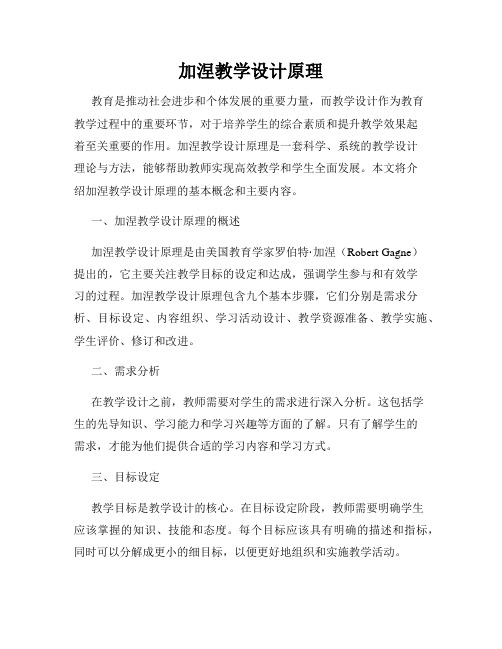
加涅教学设计原理教育是推动社会进步和个体发展的重要力量,而教学设计作为教育教学过程中的重要环节,对于培养学生的综合素质和提升教学效果起着至关重要的作用。
加涅教学设计原理是一套科学、系统的教学设计理论与方法,能够帮助教师实现高效教学和学生全面发展。
本文将介绍加涅教学设计原理的基本概念和主要内容。
一、加涅教学设计原理的概述加涅教学设计原理是由美国教育学家罗伯特·加涅(Robert Gagne)提出的,它主要关注教学目标的设定和达成,强调学生参与和有效学习的过程。
加涅教学设计原理包含九个基本步骤,它们分别是需求分析、目标设定、内容组织、学习活动设计、教学资源准备、教学实施、学生评价、修订和改进。
二、需求分析在教学设计之前,教师需要对学生的需求进行深入分析。
这包括学生的先导知识、学习能力和学习兴趣等方面的了解。
只有了解学生的需求,才能为他们提供合适的学习内容和学习方式。
三、目标设定教学目标是教学设计的核心。
在目标设定阶段,教师需要明确学生应该掌握的知识、技能和态度。
每个目标应该具有明确的描述和指标,同时可以分解成更小的细目标,以便更好地组织和实施教学活动。
四、内容组织内容组织是教学设计的重要一环。
在这个阶段,教师需要根据学习目标,选择和组织教学内容。
合理的内容组织能够帮助学生理解和吸收知识,并且能够促进学生的深层次学习。
五、学习活动设计学习活动设计是加涅教学设计原理的关键步骤之一。
在这个阶段,教师需要设计多样化的学习活动,来促进学生的积极参与和主动学习。
这些学习活动可以包括小组讨论、实践操作、案例分析等,以提高学生的学习效果。
六、教学资源准备在教学活动实施之前,教师需要准备好所需要的教学资源。
这包括教学用具、教材、多媒体设备等方面的准备。
有充分准备的教师能够更好地支持学生的学习,并提供丰富多样的教育资源。
七、教学实施教学实施是加涅教学设计原理的核心环节。
在教学过程中,教师需要灵活运用不同的教学方法和策略,以满足学生的不同需求和学习方式。
加涅的教学系统设计理论

加涅的教学系统设计理论
加涅的教学系统设计理论是由美国教育学家贝娅·加涅于20世纪50年代提出的一种教学设计理论。
加涅认为,教学系统应该具有确定的目标和有序的结构,以促进学生的学习成长。
在加涅的理论中,教学系统包括三个层次:教学课程、教学单元和教学活动。
首先,教学课程是教学系统设计的第一层次。
教学课程是指整个学习过程的规划和安排,它包括课程的目标、内容、教学策略和评估方法等。
在设计教学课程时,应该明确学生需要掌握的知识和技能,并确定教学目标。
此外,教学课程还应该根据学生的学习特点和学习风格,选择适合的教学策略和教具。
其次,教学单元是教学系统设计的第二层次。
教学单元是指教学课程的组成部分,它包括教学课程中具体的教学主题或单元。
在设计教学单元时,应该根据教学课程的目标和内容,确定具体的教学主题和学习任务。
此外,教学单元还应该根据学生的学习特点和学习需求,选择适合的教学方法和教学资源。
最后,教学活动是教学系统设计的第三层次。
教学活动是指教学单元中具体的学习活动,它包括教师的教学方法、学生的学习任务和学习环境等。
在设计教学活动时,应该根据教学单元的目标和内容,选择适合的教学方法和学习活动。
此外,教学活动还应该激发学生的学习兴趣,提供积极的学习环境。
综上所述,加涅的教学系统设计理论强调教学的系统性和有序性。
教学系统设计应该从教学课程、教学单元和教学活动三个层次进行规划和安
排,以促进学生的学习成长。
这一理论为教师提供了一种有效的教学设计方法,帮助他们更好地组织和管理学习过程,提高学生的学习效果。
试述加涅的教学事项理论的主要内容。
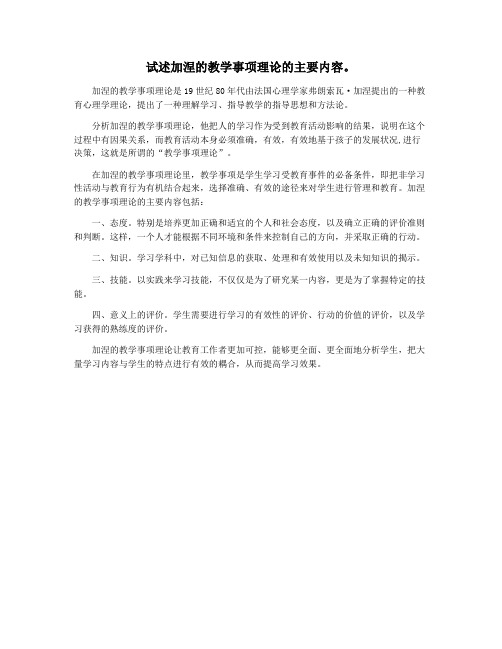
试述加涅的教学事项理论的主要内容。
加涅的教学事项理论是19世纪80年代由法国心理学家弗朗索瓦·加涅提出的一种教育心理学理论,提出了一种理解学习、指导教学的指导思想和方法论。
分析加涅的教学事项理论,他把人的学习作为受到教育活动影响的结果,说明在这个过程中有因果关系,而教育活动本身必须准确,有效,有效地基于孩子的发展状况,进行决策,这就是所谓的“教学事项理论”。
在加涅的教学事项理论里,教学事项是学生学习受教育事件的必备条件,即把非学习性活动与教育行为有机结合起来,选择准确、有效的途径来对学生进行管理和教育。
加涅的教学事项理论的主要内容包括:
一、态度。
特别是培养更加正确和适宜的个人和社会态度,以及确立正确的评价准则和判断。
这样,一个人才能根据不同环境和条件来控制自己的方向,并采取正确的行动。
二、知识。
学习学科中,对已知信息的获取、处理和有效使用以及未知知识的揭示。
三、技能。
以实践来学习技能,不仅仅是为了研究某一内容,更是为了掌握特定的技能。
四、意义上的评价。
学生需要进行学习的有效性的评价、行动的价值的评价,以及学习获得的熟练度的评价。
加涅的教学事项理论让教育工作者更加可控,能够更全面、更全面地分析学生,把大量学习内容与学生的特点进行有效的耦合,从而提高学习效果。
加涅教学设计理论体系分析

加涅教学设计理论体系分析首先,加涅教学设计理论体系的基本原则包括任务型原则、可变性原则和适应性原则。
任务型原则是指教学设计应该以学生的任务为中心,强调学生的能动性和学习的实际应用。
可变性原则是指教学设计应该具有灵活性和可调节性,以应对不同学生的不同需求和兴趣。
适应性原则是指教学设计应该根据学生的特点和发展需求来进行个性化的调整和优化。
其次,加涅教学设计理论体系的设计过程包括目标设定、诊断、预测、实施和评价。
目标设定是指明确教学目标和期望的具体内容和要求,包括知识、技能和态度等方面。
诊断是指对学生的现状和需求进行调查和分析,以确定教学的起点和重点。
预测是指对学习的难点和可能的困惑进行预测和准备,以提前解决和预防问题。
实施是指教学活动的具体过程和方法,包括教学资源的准备、教学环境的创设和教师的引导等。
评价是指对学生学习成果和教学过程进行反馈和评价,以及对教学设计进行总结和改进。
再次,加涅教学设计理论体系的设计要素包括学习任务、学习资源、学习环境和学习评价。
学习任务是指学生需要完成的具体学习任务和要求,应该清晰明确,具有挑战性和启发性。
学习资源是指为学生提供的学习材料、工具和支持,包括书籍、设备、软件和网络等。
学习环境是指创设和构建的有利于学生学习和探究的环境,包括物理环境和社会环境两个方面。
学习评价是指对学生学习成果和教学过程进行评价和反馈,以指导学生的学习和教师的教学改进。
最后,加涅教学设计理论体系的意义在于提供了一个有系统性和科学性的教学设计框架和方法,可以帮助教师设计出更有效、灵活和适应性的教学方案。
它强调学生的主动性和实际应用,注重个性化和差异化的教学,有助于提高教学效果和学生学习成就。
同时,加涅教学设计理论体系也可以促进教师的教学发展和专业成长,增强其教学设计能力和教学创新意识。
综上所述,加涅教学设计理论体系是一个重要的教学设计理论,它包括基本原则、设计过程和设计要素等方面的内容,具有指导性和实践性的特点,对于提高教学效果和促进学生发展具有重要意义。
罗伯特加涅的九大教学事件
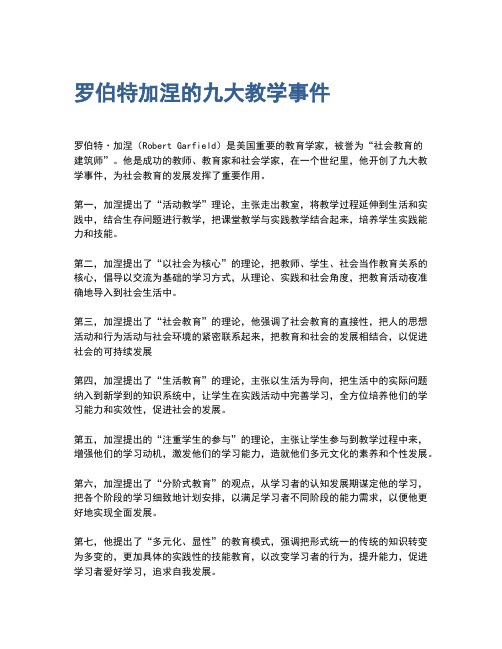
罗伯特加涅的九大教学事件罗伯特·加涅(Robert Garfield)是美国重要的教育学家,被誉为“社会教育的建筑师”。
他是成功的教师、教育家和社会学家,在一个世纪里,他开创了九大教学事件,为社会教育的发展发挥了重要作用。
第一,加涅提出了“活动教学”理论,主张走出教室,将教学过程延伸到生活和实践中,结合生存问题进行教学,把课堂教学与实践教学结合起来,培养学生实践能力和技能。
第二,加涅提出了“以社会为核心”的理论,把教师、学生、社会当作教育关系的核心,倡导以交流为基础的学习方式,从理论、实践和社会角度,把教育活动夜准确地导入到社会生活中。
第三,加涅提出了“社会教育”的理论,他强调了社会教育的直接性,把人的思想活动和行为活动与社会环境的紧密联系起来,把教育和社会的发展相结合,以促进社会的可持续发展第四,加涅提出了“生活教育”的理论,主张以生活为导向,把生活中的实际问题纳入到新学到的知识系统中,让学生在实践活动中完善学习,全方位培养他们的学习能力和实效性,促进社会的发展。
第五,加涅提出的“注重学生的参与”的理论,主张让学生参与到教学过程中来,增强他们的学习动机,激发他们的学习能力,造就他们多元文化的素养和个性发展。
第六,加涅提出了“分阶式教育”的观点,从学习者的认知发展期谋定他的学习,把各个阶段的学习细致地计划安排,以满足学习者不同阶段的能力需求,以便他更好地实现全面发展。
第七,他提出了“多元化、显性”的教育模式,强调把形式统一的传统的知识转变为多变的,更加具体的实践性的技能教育,以改变学习者的行为,提升能力,促进学习者爱好学习,追求自我发展。
第八,加涅提出的“认知化”的教学模式,主张把学习的多种维度整合,通过“认知系统”的记忆机制,将学习的过程像构建一个有机体一样良好地耦合在一起,使得学习者能够在多方面做出反应,扩展学习体系。
最后,加涅提出了“实践认知”的教学模式,他把课堂外在的实践经验与学习者的认知理论结合起来,使得学习者能够将课堂上学习到的知识付诸实践。
加涅教学设计理论评价

加涅教学设计理论评价引言:教学设计是教育教学工作中的一项重要任务,对于提高教学质量和学生成绩有着至关重要的作用。
加涅教学设计理论作为一种教学设计方法论,对于指导教师进行高效的教学设计具有一定的指导意义。
本文将从理论、特点、优点和应用等方面对加涅教学设计理论进行综合评价,旨在为广大教师提供参考和借鉴。
一、加涅教学设计理论的概述加涅教学设计理论是由美国教育家罗伯特·加涅在20世纪70年代提出的,他认为教学设计应该是“从学生的角度出发,以促进学习为中心的过程”,并提出了“诱发式教学设计”的概念。
加涅教学设计理论强调了学生的主体性和积极性,在教学设计过程中,鼓励学生参与到学习活动中,通过自主探究和合作学习来提高学习效果。
二、加涅教学设计理论的特点1. 以学生为中心:加涅教学设计理论将学生的学习需求和兴趣放在教学设计的首位,通过深入了解学生的特点和需求来设计符合他们学习需求的教学活动。
2. 强调启发式教学:加涅教学设计理论倡导启发式教学,即通过提出问题、引发学生思考来激发学生的学习兴趣和主动性,从而使学生更好地掌握知识和技能。
3. 注重学科整合:加涅教学设计理论主张将不同学科的知识进行有机整合,通过跨学科的教学设计来促进学生的综合能力发展。
4. 强调反思和评价:加涅教学设计理论主张在教学设计过程中加强反思和评价,通过对教学实施效果的评估来持续优化教学设计,实现教学效果的不断提高。
三、加涅教学设计理论的优点1. 激发学生的学习兴趣和主动性:加涅教学设计理论通过启发式教学的方法激发学生的学习兴趣和主动性,使学习变得更加积极主动。
2. 提高学生的学习效果:加涅教学设计理论重视学生的参与和合作学习,通过自主探究和合作学习来提高学生的学习效果。
3. 发展学生的综合能力:加涅教学设计理论强调学科整合和跨学科教学设计,有助于促进学生的创新思维和综合能力的发展。
4. 实现教学效果的不断提高:加涅教学设计理论主张加强教学过程中的反思和评价,通过不断评估和优化教学设计,实现教学效果的不断提高。
加涅的认知学习理论
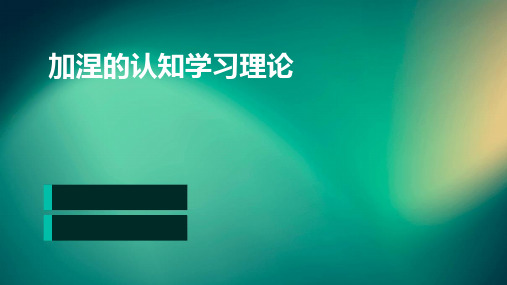
关注学生的学习过程和方法,及时发现和纠正学生的学习问题,促 进学生的持续进步和发展。
教师角色转变与专业发展
由知识传授者转变为学习促进者
教师不再仅仅是知识的传授者,而是学生学习过程中的引导者 和促进者,帮助学生发现问题、解决问题和自主学习。
不断提升专业素养
教师需要不断学习和更新自己的知识结构和教学方法,提 高自己的专业素养和教育教学能力。
理论背景
在行为主义和认知主义两大学习理论流派的基础上,加涅提出了独具特色的认知学习理论。他认为学习是一个复 杂的过程,涉及多个阶段和内部心理活动。
认知学习理论的核心观点
学习的信息加工模式
01
加涅认为学习是一个信息加工的过程,包括注意、记忆、思维
等心理活动的参与。
学习的阶段性
02
加涅将学习过程划分为多个阶段,每个阶段都有其特定的任务
加强教师之间的合作与交流
教师需要加强彼此之间的合作与交流,共同研究和解决教 育教学中的问题,促进教育教学质量的不断提高。
THANKS FOR WATCHING
感谢您的观看
学习环境
学习环境包括物理环境和社会环境两个方面。安静、舒适、有良好学习氛围的物理环境和积极互动、互相支 持的社会环境可以促进学习者的学习效果。
个体差异与认知学习
01
学习风格的差异
02
智力水平的差异
不同的学习者有不同的学习风格,如 视觉型、听觉型和动觉型等。针对不 同学习风格提供相应的教学方法和资 源可以提高学习效果。
学会自我调节
教授学生一些自我调节的技巧,ቤተ መጻሕፍቲ ባይዱ深呼吸、放松训练、积极思考等,以帮助他们缓解学习压力和 焦虑情绪,保持良好的学习状态。
高等教育心理学 简述加涅把教学分成九个顺序事件的主要内容

高等教育心理学简述加涅把教学分成九个顺序事件的主要内容摘要:一、引言1.介绍加涅的教学理论2.阐述加涅将教学分成九个顺序事件的目的二、九个顺序事件的概述1.引起注意2.维持注意3.呈现刺激4.唤起反应5.给予反馈6.加强反应7.激发保持8.评估作业9.促进记忆三、九个顺序事件的详细解析1.引起注意:通过合理设计课程内容,激发学生的兴趣,使学生对新知识产生好奇心2.维持注意:教师运用恰当的教学方法和手段,确保学生在学习过程中保持关注3.呈现刺激:利用多种教学资源,如图片、视频等,引导学生主动探索和思考4.唤起反应:设计互动环节,鼓励学生积极参与,激发学生的学习潜能5.给予反馈:教师对学生的学习成果给予及时、准确的反馈,以便学生了解自己的进步6.加强反应:教师针对学生的不足之处,提出建设性意见,促使学生改进7.激发保持:引导学生树立长期的学习目标,保持学习的动力和信心8.评估作业:通过合理设置考核方式,检验学生的学习效果9.促进记忆:教授学生有效的记忆方法,提高学习成果的长期保持能力四、加涅教学理论在我国高等教育心理学的应用1.理论指导作用:加涅的教学理论为我国高等教育心理学提供了理论依据2.实践应用价值:加涅的教学理论对我国高等教育心理学的实际教学具有指导意义五、总结1.加涅教学理论的重要性2.提高我国高等教育心理学教学质量的方法和策略正文:高等教育心理学是一门研究大学生心理发展规律及其教育对策的学科。
在这门学科中,加涅的教学理论具有重要的地位。
他认为,教学过程可以分成九个顺序事件,这些事件相互关联,共同构成一个完整的教学过程。
本文将对这九个顺序事件进行简要阐述,以期为我国高等教育心理学的教学提供参考。
加涅的教学理论旨在指导教师如何更好地组织教学活动,提高学生的学习效果。
他将教学过程划分为以下九个顺序事件:引起注意、维持注意、呈现刺激、唤起反应、给予反馈、加强反应、激发保持、评估作业和促进记忆。
这些事件环环相扣,构成了一个完整的教育心理学体系。
加涅的教学系统设计理论

加涅的教学系统设计理论加涅的教学系统设计理论是马克·加涅在其教育心理学研究中形成的一种教学设计理念。
加涅认为,合理的教学系统设计应该从教学目标、教学方法、教学内容和教学评价等方面综合考虑,以达到最优的教学效果。
以下将详细介绍加涅的教学系统设计理论。
首先,加涅将教学目标作为设计教学系统的重要出发点。
教学目标应该是明确的、具体的、具有挑战性的,并且与学生现有知识和技能水平相适应。
通过设定明确的教学目标,可以帮助学生提高学习动机和学习效果。
教学目标应该能够在一定程度上反映学生的学习需求和教师的教学愿望,从而形成完整的教学体系。
其次,加涅提出了多种教学方法的应用。
不同的学生有不同的学习风格和学习习惯,因此教师需要根据学生的特点选择恰当的教学方法。
加涅主张教师要采用多样化的教学方法,包括讲授、讨论、实践、合作学习等,以满足不同学生的学习需求。
同时,教师要灵活运用各种教学媒介和技术手段,如多媒体教学、互联网教学等,以增强教学效果。
第三,加涅强调教学内容的合理性和适应性。
教学内容应该与学生的兴趣、背景和学习目标相适应,能够激发学生的学习兴趣和积极性。
教学内容应该以学科知识为基础,同时注重培养学生的思维能力、创新能力和实践能力。
在设计教学内容时,教师需要进行创新和更新,以适应不断变化的社会和学生需求。
最后,加涅强调教学评价在教学系统设计中的重要性。
教学评价是教学效果的重要标志,能够帮助教师了解学生的学习情况和教学过程的效果。
教学评价应该具有客观性、科学性和全面性,通过多种评价方式,包括考试、作业、讨论、观察等,对学生的学习情况进行全面评价。
教学评价需要及时反馈给学生,帮助他们了解自己的学习差距和不足,以便进一步调整学习策略。
综上所述,加涅的教学系统设计理论强调教学目标、教学方法、教学内容和教学评价的综合考虑。
教师需要根据学生的特点和需求,合理设计教学系统,以提高学生的学习效果和发展潜力。
加涅的教学系统设计理论对于提高教学质量、培养学生综合素质具有重要的指导作用。
- 1、下载文档前请自行甄别文档内容的完整性,平台不提供额外的编辑、内容补充、找答案等附加服务。
- 2、"仅部分预览"的文档,不可在线预览部分如存在完整性等问题,可反馈申请退款(可完整预览的文档不适用该条件!)。
- 3、如文档侵犯您的权益,请联系客服反馈,我们会尽快为您处理(人工客服工作时间:9:00-18:30)。
加涅的教学理论
加涅根据信息加工心理学原理提出了一个得到广泛认可的学习和记忆的信息加
工模型。
他把完整的教学过程划分为9个阶段:引起注意、告知目标、提示回忆原有知识、呈现教材、提供学习知道、引出作业、提供反馈、评估作业和促进保持与迁移。
引起注意是教学过程中的首要因素。
从信息加工的观点来看,如果个体对作用于感觉器官的刺激信息未加注意,那么,这些信息就会在很短的时间内遗忘。
知识教学的基本目的是要使学生将知识存入长时记忆;因为只有存入长时记忆的知识,学生才能用它来学习新知识或解决问题。
因此,教师在教学过程开始时,即课堂导入时,必须要考虑:怎样才能引起学生对学业的注意。
Gagne's Instructional Theory
Gagne psychology of information processing in accordance with a principle widely recognized in the learning and memory model of information processing. He integrity of the teaching process is divided into nine stages: attention, notification of the target, suggesting that memories of the original knowledge, a teaching materials, learning to know, lead to operations, provide feedback, assess operations and facilitate the maintenance and migration. Attention in the teaching process is the primary factor. Information processing from the point of view, if the individual for the role of information in sensory stimulation does not increase the attention, then the information will be in a very short period of time forgotten. Knowledge of teaching students the basic aim is to put knowledge into long-term memory; because only long-term memory into knowledge, students can use it to acquire new knowledge or solve the problem. Therefore, teachers in the teaching process begins, that is, into the classroom, we must consider: How can we arouse the attention of students to their studies.。
